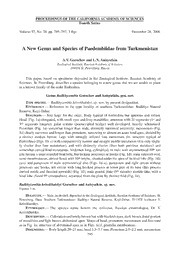
A New Genus and Species of Paedembiidae from Turkmenistan PDF
Preview A New Genus and Species of Paedembiidae from Turkmenistan
PROCEEDINGS OFTHE CALIFORNIAACADEMYOFSCIENCES Fourth Series Volume 57, No. 28, pp. 795–797, 3 figs. December 28, 2006 A New Genus and Species of Paedembiidae from Turkmenistan A.V. Gorochov and L.N. Anisyutkin Zoological Institute, Russian Academy of Sciences, 199034 St. Petersburg, Russia This paper, based on specimens deposited in the Zoological Institute, Russian Academy of Sciences, St. Petersburg, describes a species belonging to a new genus that we are unable to place in a known family of the order Embiidina. Genus BadkhyzembiaGorochov and Anisyutkin, gen. nov. TYPESPECIES.—Badkhyzembia krivokhatskyi, sp. nov, by present designation. ETYMOLOGY.—Reference to the type locality in southern Turkmenistan: Badkhyz Natural Reserve, Kzyl-Dzhar. DIAGNOSIS.—Size large for the order. Body typical of Embiidina but apterous and robust. Head (Fig. 1a) elongated, with small eyes and long mandibles; antennae with 20 segments (1stand 3rd segments longest); gular sclerite (postoccipital bridge) well developed, heavily sclerotized. Pronotum (Fig. 1a) somewhat longer than wide, distinctly narrowed anteriorly; mesonotum (Fig. 1a) clearly narrower and longer than pronotum, narrowing to almost an acute hind apex, divided by a distinct median furrow. Legs with strongly inflated fore metatarsus (its structure typical of Embiidina) (Figs. 1b–c) with comparatively narrow and straight middle metatarsus (it is only slight- ly shorter than fore metatarsus), and with distinctly shorter (than both previous metatarsi) and somewhat curved hind metatarsus. Abdomen long, cylindrical, in male with asymmetrical 10thter- gite having a large rounded hind lobe, but lacking processes or hooks (Fig. 1d); male epiproct oval, semi-membraneous, almost fused with 10thtergite, situated under the apex of its hind lobe (Fig. 1d); cerci and paraprocts of male asymmetrical also (Figs. 1d–e), paraprocts and right cercus without processes and hooks, left cercus with long hooked process at lower part of its base (this process curved inside and directed upwards) (Fig. 1f); male genital plate (9th sternite) sternite-like, with a hind lobe (fused 9thcoxopodites), separated from the plate by distinct fold (Fig. 1e). Badkhyzembia krivokhatskyiGorochov and Anisyutkin, sp. nov. Figures 1–4. HOLOTYPE.—Male, in alcohol, deposited in the Zoological Institute, Russian Academy of Sciences, St. Petersburg. Data: Southern Turkmenistan: Badkhyz Natural Reserve, Kzyl-Dzhar, IV-1978 (collector V. Krivokhatsky). ETYMOLOGY.—The species name honors the collector, Russian entomologist, Dr. V. Krivokhatsky. DESCRIPTION.—Coloration uniformly brown but with blackish eyes, dark brown distal portion of mandibles and light brown abdominal apex. Shape of head, pronotum, mesonotum and fore tarsi as in Fig. 1a; structure of abdominal apex as in Figs. 1d,f; genitalia membranous. DIMENSIONS.—Body length 20–23 mm, head 3.5–3.7 mm. Pronotum 2.0–2.2 mm, mesonotum 795 796 PROCEEDINGS OF THE CALIFORNIAACADEMYOF SCIENCES Fourth Series, Volume 57, No. 28 FIGURE1. Characters of a male Badkhyzembia krivokhatskyin. sp. (a) head, pronotum, and mesonotum from above; (b) fore tibia and tarsus from side; (c) fore metatarsus from below; (d) abdominal apex from above; (e) from below; (f) from behind. Abbreviations: c = coxopodites of 9th sternite, g = genital plate (9th sternite), p = paraproct, 10t = 10th tergite. Drawings and caption furnished by Gorochov. 2.8–3.0 mm, fore femora 2.0–2.2 mm, fore tibiae 2.1–2.3 mm, fore metatarsi 1.8–1.9 mm, middle femora 2.1–2.3 mm, middle tibiae 2.2–2.4 mm, middle metatarsi 1.6–1.7 mm, hind femora 2.9–3.1 mm, hind tibiae 2.4–2.6 mm, hind metatarsi 1.0–1.1 mm, cerci 1.7–1.8 mm. VARIATION.—One of paratypes has a somewhat shorter process of left cercus and the apical part of this process is directed more or less backwards. Apparently it was deformed during molting. FEMALES.—No specimens. DISCUSSION.—The following comments and additional figures were contributed by Dr. Edward Ross, based on his study of a topotypic male paratype of this species deposited by exchange in the CAS collection: “Family characters.—The two included genera have in common: a soft general body, tan col- oration, similar cranial and mandibular form, a peculiar, narrowly-triangulate mesonotum with a unique, longitudinal, medial furrow, similar legs, and a tenth tergite without cleavage or processes. “Species characters.—The molar area of the mandibles of krovokhatskiis slightly shorter than in afghanica. The inner side of the hind basitarsus of krivokhatskihas very sparse setae and the mid- dle segment lacks stout setae. In contrast, both sides of the afghanica’s basitarsus and the mid seg- ment have numerous stout setae (see Ross [this issue], Fig. 2). As mentioned, there are profound distinctions in the form of the cercus segments, especially in the processes of the basal segment of the left cercus. GOROCHOV& ANISYUTKIN: NEWGENUS AND SPECIES OF PAEDEMBIIDAE 797 FIGURE3. Caudal aspect of terminalia of a paratype of B. krivokhatskyi. Drawing by E.S. Ross. FIGURE 2. Dorsal and ventral aspects of terminalia of a paratype of Badkhzembia krivokhatskyi (setae omitted). Drawing by E.S. Ross. “I have contributed terminalia figures of a paratype of B. krivokhatski (Figs. 2–3).” ACKNOWLEDGMENTS We wish to thank Dr. Edward S. Ross of the California Academy of Sciences for his assistance and collaboration in this study. Copyright © 2006 by the California Academy of Sciences San Francisco, California, U.S.A.
